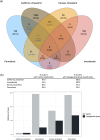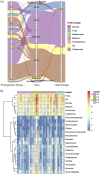RNA Viruses Linked to Eukaryotic Hosts in Thawed Permafrost
- PMID: 36453933
- PMCID: PMC9765123
- DOI: 10.1128/msystems.00582-22
RNA Viruses Linked to Eukaryotic Hosts in Thawed Permafrost
Abstract
Arctic permafrost is thawing due to global warming, with unknown consequences on the microbial inhabitants or associated viruses. DNA viruses have previously been shown to be abundant and active in thawing permafrost, but little is known about RNA viruses in these systems. To address this knowledge gap, we assessed the composition of RNA viruses in thawed permafrost samples that were incubated for 97 days at 4°C to simulate thaw conditions. A diverse RNA viral community was assembled from metatranscriptome data including double-stranded RNA viruses, dominated by Reoviridae and Hypoviridae, and negative and positive single-stranded RNA viruses, with relatively high representations of Rhabdoviridae and Leviviridae, respectively. Sequences corresponding to potential plant and human pathogens were also detected. The detected RNA viruses primarily targeted dominant eukaryotic taxa in the samples (e.g., fungi, Metazoa and Viridiplantae) and the viral community structures were significantly associated with predicted host populations. These results indicate that RNA viruses are linked to eukaryotic host dynamics. Several of the RNA viral sequences contained auxiliary metabolic genes encoding proteins involved in carbon utilization (e.g., polygalacturosase), implying their potential roles in carbon cycling in thawed permafrost. IMPORTANCE Permafrost is thawing at a rapid pace in the Arctic with largely unknown consequences on ecological processes that are fundamental to Arctic ecosystems. This is the first study to determine the composition of RNA viruses in thawed permafrost. Other recent studies have characterized DNA viruses in thawing permafrost, but the majority of DNA viruses are bacteriophages that target bacterial hosts. By contrast RNA viruses primarily target eukaryotic hosts and thus represent potential pathogenic threats to humans, animals, and plants. Here, we find that RNA viruses in permafrost are novel and distinct from those in other habitats studied to date. The COVID-19 pandemic has heightened awareness of the importance of potential environmental reservoirs of emerging RNA viral pathogens. We demonstrate that some potential pathogens were detected after an experimental thawing regime. These results are important for understanding critical viral-host interactions and provide a better understanding of the ecological roles that RNA viruses play as permafrost thaws.
Keywords: RNA virus; metatranscriptomics; permafrost thaw; soil virus.
Conflict of interest statement
The authors declare no conflict of interest.
Figures




References
-
- Ricketts MP, Matamala R, Jastrow JD, Antonopoulos DA, Koval J, Ping C-L, Liang C, Gonzalez-Meler MA. 2020. The effects of warming and soil chemistry on bacterial community structure in Arctic tundra soils. Soil Biol Biochem 148:107882. doi:10.1016/j.soilbio.2020.107882. - DOI
-
- Hultman J, Waldrop MP, Mackelprang R, David MM, McFarland J, Blazewicz SJ, Harden J, Turetsky MR, McGuire AD, Shah MB, VerBerkmoes NC, Lee LH, Mavrommatis K, Jansson JK. 2015. Multi-omics of permafrost, active layer and thermokarst bog soil microbiomes. Nature 521:208–212. doi:10.1038/nature14238. - DOI - PubMed
-
- Mackelprang R, Saleska SR, Jacobsen CS, Jansson JK, Taş N. 2016. Permafrost meta-omics and climate change. Annu Rev Earth Planet Sci 44:439–462. doi:10.1146/annurev-earth-060614-105126. - DOI
Publication types
MeSH terms
Substances
LinkOut - more resources
Full Text Sources
Medical
Miscellaneous
